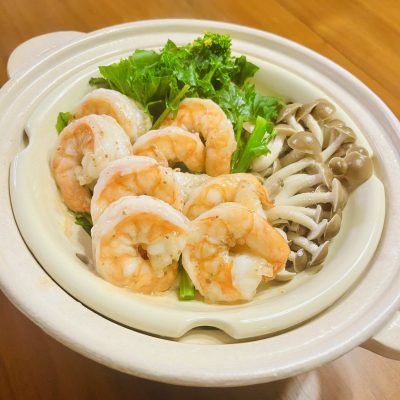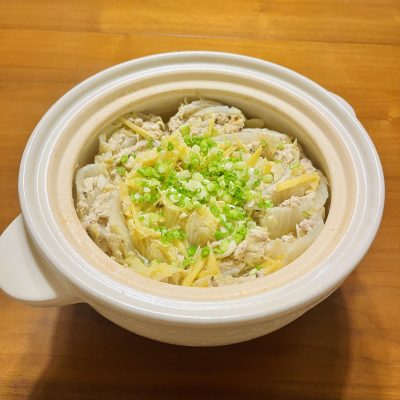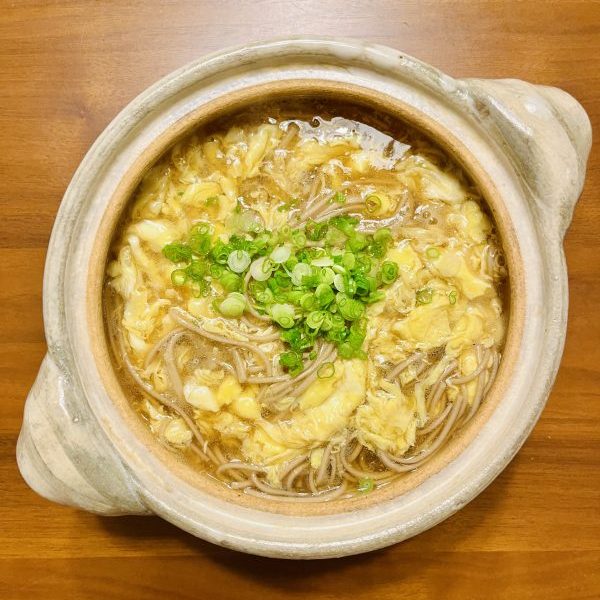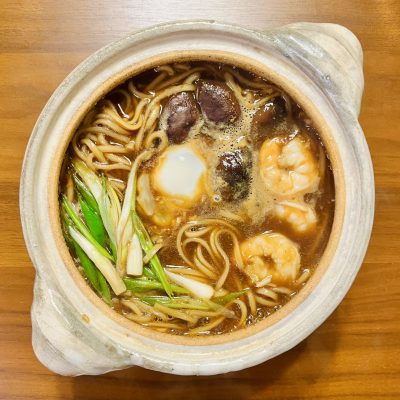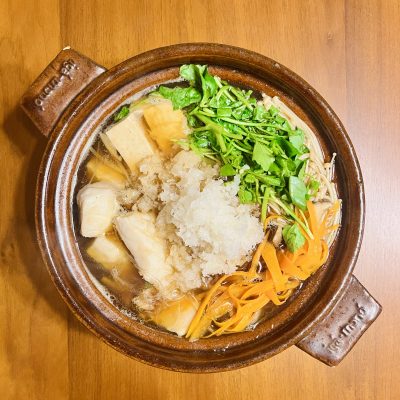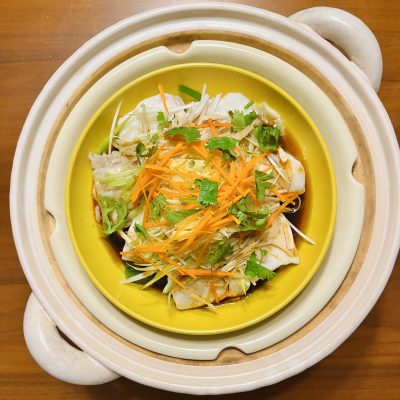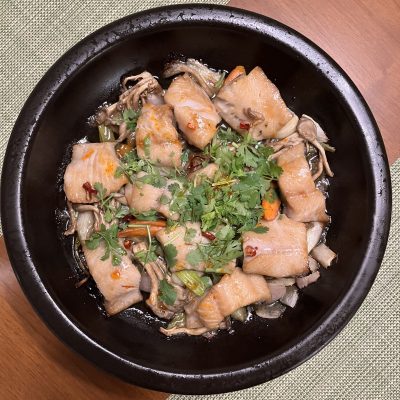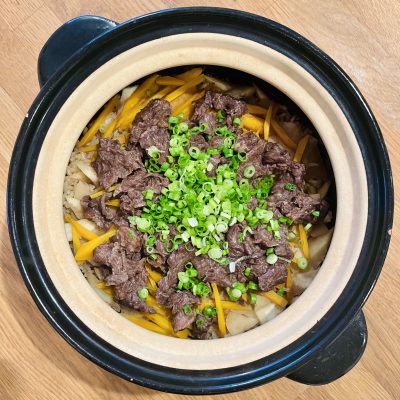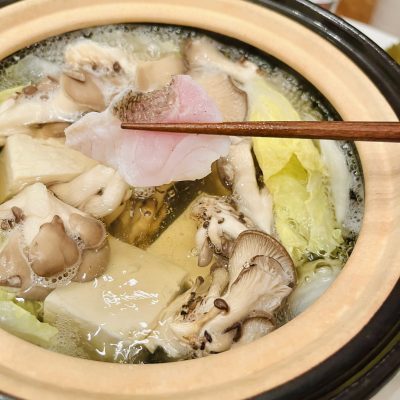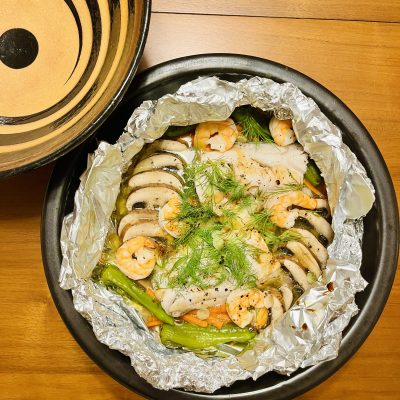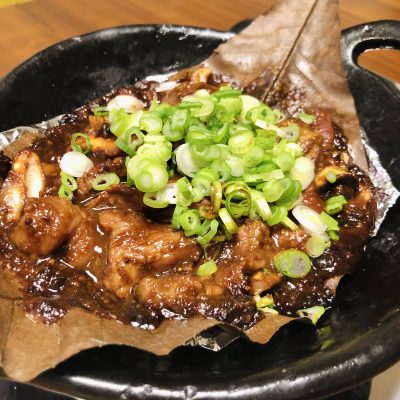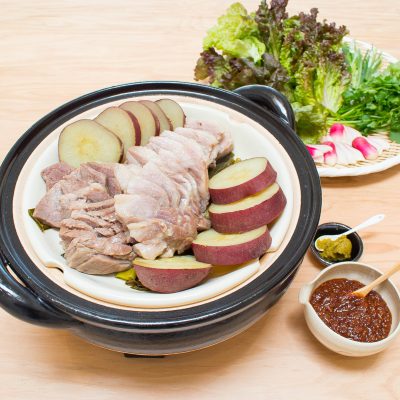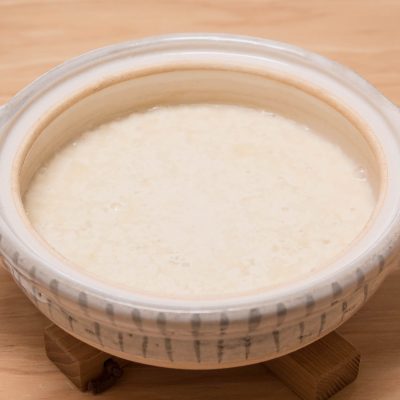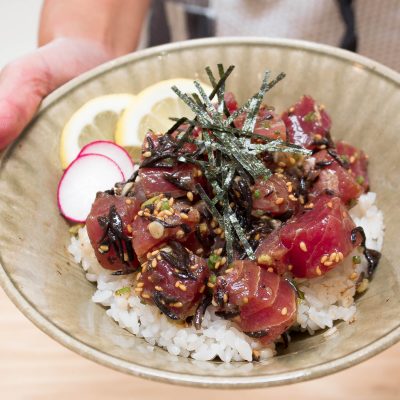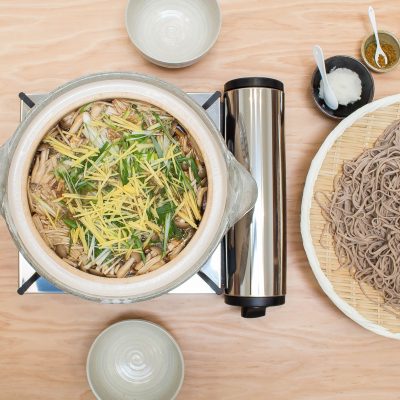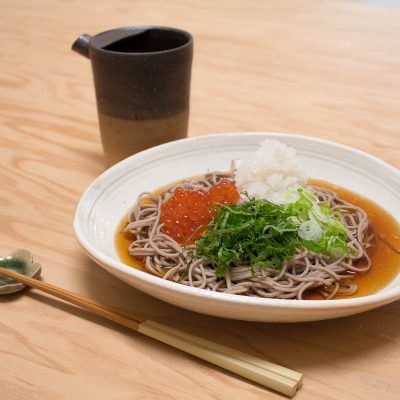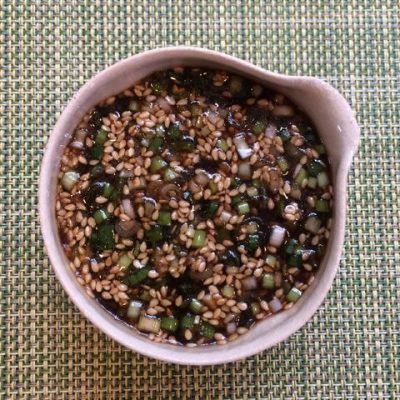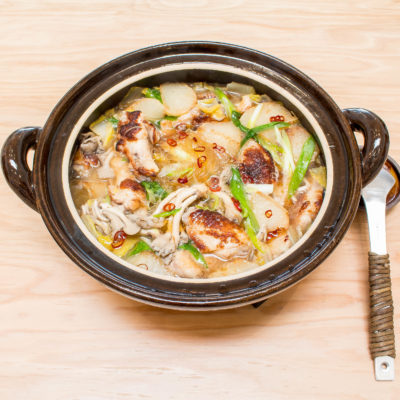Simple donabe steamed shrimp and rapini is almost a non-recipe dish and always delightful. I like to serve with my homemade Yuzu Ponzu (recipe in my DONABE Cookbook). If you opt for a ready-made ponzu, we have great ones in our pantry section, too. Sansho and sake enhances the flavor and sansho adds the nice subtle citrusy kick. The addition of katakuriko (potato starch), although it’s optional, seals the flavors and the helps the texture to be so plump.
Tag Archives: Green onion
Chicken & Tofu Mille Feuille Nabe
Here is a new variation to my “mille feuille” nabe recipes and this is a total keeper. It’s napa cabbage with ground chicken and tofu filling and tastes so rich and soothing. I season the dish with a Vegetable Dashi bag by simply tearing the bag and sprinkle the contents over the dish before cooking. This vegetable dashi bag is so convenient and the result is simply fantastic. The dish is packed with umami and already so tasty on its own, but I like to drizzle a small amount of soy sauce or a dab of Yuzu-Kosho.
Egg Drop Soba
Shrimp Miso Udon
Perfect for a cold season, this is Shrimp and Udon, Simmered in Dark Miso Broth. There is something about the deep simmering sound and look of the donabe noodles in miso broth. I make this dish repeatedly in the cold season. It’s a brilliant single serving one pot donabe meal which has rich satisfying flavors and keeps my body warm so nicely. I like to coat the shrimp in katakuriko (potato starch – you can omit or substitute with corn starch), as it helps shrimp turn really nice plump texture and also lightly thickens the broth. Also, shrimp cooks fast and adds nice flavors to the broth, but you’re welcome to omit or replace with your choice of topping.
Halibut & Daikon Hot Pot
Here’s my healthy seafood hot pot, Halibut Mizore Nabe – Halibut (or your choice of fish) is quickly simmered with vegetables and finished with a generous amount of grated daikon on top. With the addition of the glass noodles, this dish makes a very satisfying one pot donabe meal.
Chinese-Style Steamed Fish
This colorful treat is an easy one-pot dish with a lot of flavors. I like to use halibut for the rich tender texture for this dish, but you can also make it with other kinds of fish such as black cod, sea bass, salmon, etc. The fish is topped on the top parts of green onions and sprinkled with garlic slices to steam for beautiful aromas. The fish is also dusted with some katakuriko (potato starch) so this way the fish can absorb more flavors and retains moisture better, but you can cook without katakuriko, too. The sizzling sound and aroma of the smoking sesame oil when it’s poured over the fish stimulate your appetite so much. With the umami-rich sauce and aromatic toppings, this dish can become a healthy and satisfying main course.
I got the super fresh Alaskan halibut from Kai Gourmet again! They have the sustainably sourced premium sashimi quality seafood and deliver to your door, anywhere in the US. I can order by midnight and get my order overnight. I have been a huge fan of Kai Gourmet for many years.
I partnered with Kai Gourmet again and have a promo code for you. Visit their website and enter the below code to receive 10% discount for your order (full priced items only). Hope you will try their seafood!
Website: https://kaigourmet.com/
Promo Code: ToiroKai10
Garlic Black Cod
Super simple and super good. I’ve been making this dish in different kinds of donabe and the dish is always a great success. It’s a sizzling dish of generous amount of garlic etc. and oyster sauce marinated black cod, finished in the oven. Minimum effort is required to execute the dish, so it’s a perfect dish to cook for your guests at a dinner party. And everybody loves it!
The tagine-style donabe , Fukkura-san, with its flat skillet bottom, cooks the ingredients most effectively. Or, you can also use other kinds of donabe (dry-heating capable is preferred), too. For a small serving, I also like to use my compact one-handle donabe , Izakaya Nabe. Happy Donabe Life!
Beef Rice
Juicy donabe Beef Rice for your stamina. I used a block of American Wagyu hanger steak and thinly sliced by hand. By marinating the beef for a short time with sake, soy sauce and black sugar, the meat comes out so tender like you braised it! I also used some smoked soy sauce to complement the bold flavor but you can use only regular soy sauce, too. Donabe makes this dish so complete in flavor and texture, and it was just so delicious that I ate almost half of the pot. Happy Donabe Life!
Sea Bream Shabu Shabu
Spring really makes me want to eat Tai (sea bream) every day. I enjoy it in sashimi, carpaccio, sushi, etc. And, here’s another Tai dish I love, which is Tai Shabu. It’s basically a simple fish shabu shabu and always so good. If you can save enough broth, hope you enjoy the shime (finishing) noodle course, too.
Steamed Pork and Cabbage Shabu Shabu
This steamed donabe dish is so tasty and nourishing. The thinly-sliced pork and cabbage always make a great flavor combination. The ingredients are simply steamed in a donabe steamer, Mushi Nabe for 4 – 5 minutes and served with pre-prepared ponzu and garlic miso dipping sauces. Feel free to substitute any ingredients to steam and enjoy!
Baked Foil-Wrapped Seafood
Foil-baked seafood is such an easy-prepping and delicious dish. It also requires basically no cleaning of the cooking equipment. I always make it in my tagine-style donabe , Fukkura-san, as not only it distributes the heat perfectly without getting the bottom burned quickly but also it makes a very nice presentation at the table. The dish is flavored simply with sake, butter, and a drizzle of soy sauce and it’s so perfect! When the foil is gently cut open and the dish is revealed, it brings so much excitement, and also the aroma of butter-sake infused ingredients is so irresistible. Smoked soy sauce makes the dish so special but a regular soy sauce can work just fine, too.
Toban Beef with Miso Sauce
Hoba Miso is a traditional dish, originate in Hida region of Gifu, Japan. This mountainous region is situated in the northern end of Gifu and has a long snowy winter. So, many preserved foods, including miso, pickles, koya tofu (freeze-dry tofu) etc., were developed there. Hoba Miso is one of their traditional dishes and it’s basically a miso-based sauce, cooked on a dry magnolia leaf. One of the most popular toppings for this dish is beef, as Gifu is famous for its premium Hida Beef, and it’s one of my favorite dishes from Gifu! Here in LA, I enjoy making this dish cooked in Toban (donabe skillet) with local beef. Every time I make this dish, it makes me want to visit Gifu again. Hoba (magnolia) leaf is not readily available in the US, so you can be creative with a different leaf (like a banana leaf?) or simply place a parchment paper on a Toban to cook it.
Tuna Hot Pot
One day, a very good customer of ours stopped by at our shop to give us a block of fresh tuna he just caught from fishing in the Pacific Ocean. How sweet of him! It was super fresh sashimi quality, so we tried some as sashimi with different kinds of soy sauces we have, then for the remaining, I decided to make a donabe hot pot with it. Tuna hot pot in donabe is a popular dish in Japan, and it’s typically made as a combination with negi (Japanese green onion). It’s called Negi-Ma Nabe. The name is short for Negi (green onion) Maguro (tuna) Nabe (hot pot).
This dish is very simple, and all you need is good quality dashi, tuna (obviously!), green onion (for the name’s sake) and any other ingredients you like to add. I like it with my ponzu.
For the shime (finishing course), I like making quick ojiya (porridge) with freshly-cooked donabe rice.
Soba Noodle with Green Onion and Shiitake Mushroom
Soba noodle is one of the most beloved traditional Japanese foods in Japan. Many people enjoy soba dishes for lunch, and there are soba restaurants (many are hand-made) and stands everywhere in Japan. At home, soba makes a very popular meal. This is my quick soba noodle dish I love and make all the time for lunch, and I change the toppings according to what I have in my fridge or pantry. Sometimes, I serve with just mushrooms, wakame seaweed, or even completely plain with a dash of yuzu citrus zest. With the porous body of the donabe, I like that the broth stays hot until the end of the meal.
Steamed Moshio-Salt-Marinated Pork Shoulder
This dish was inspired by a popular Korean dish, bossam, which I love. In bossam, boiled pork belly block is sliced and served with condiments, and you can make a wrap with a napa cabbage leaf. In my version, I start with a pork shoulder block and marinade it with Moshio (seaweed sea salt) for overnight to a full day. If you don’t have moshio, you can use other kind sea salt, but moshio really makes the flavor so rich and complex, and also tenderize the meat very well. The meat is, then, steamed in donabe, and sliced to serve with lettuce leaves and condiments. You can make it with pork belly, too.
This dish is so simple to make and is also real fun dish to share at a table. All you have to do for cooking is simply put a block of salt-marinated pork shoulder in the Mushi Nabe, and steam for about 30 minutes or until done. When you are entertaining guests, you can pre-cook the meat in advance, and just reheat in the donabe before service. If you slice the meat in front of the guests, it will bring out more excitement. Then, at the table, you can have lettuce and condiments ready, and everybody can make his/ her own wraps. The meat is so tender and flavorful, and it’s pretty hard to stop eating once you start.
Homemade Tofu
Authentic fresh tofu can be made at home very easily, once you have a donabe and high quality soymilk. All you need to do is to heat soymilk, stir in nigari liquid, turn off the heat, and rest until the mixture sets to become tofu. Iga-yaki donabe is perfect for fresh tofu making, because the porous body achieves the gentle and even heat distribution. It also cools down very slowly after turning off the heat, so the tofu can set to ideal stage during the resting time. The fresh warm tofu right out of donabe is simply a joy and I always have my first few tastes without any seasonings or condiments. It’s so fluffy, delicate, and pure. Then, I enjoy it with different toppings. Sometimes simply with shaved katsuobushi (shaved dried bonito flakes) and soy sauce, or wasabi, sea salt (such as moshio sea salt), and sesame oil. Ponzu is great, too.
Premium quality Banrai Soymilk and Banrai Nigari Liquid are both available at our shop. So, hope you give it a try. You can make a full-size sukui tofu to share or a small individual-size tofu in a mini-size donabe for everyday breakfast.
The recipe introduced in this page is calling for 1-liter soymilk. For the half amount, you can use a small-size classic-style donabe (approx. 0.8-qt/ 800 ml size). The photos below are made with small-size Rikyu-Tokusa donabe.
For an idividual-size silky tofu making method, please see Banrai Soymilk and Banrai Nigari Liquid product page.
Tuna Poke Rice Bowl
As I have been to Hawaii almost 50 times since I was a teenager and I’ve been loving their local seafood dishes, I am a self-claimed poke expert (haha). My favorite style of poke is quite simple…it’s all about high quality tuna, soy sauce, sesame oil, and wasabi. When I serve it as an appetizer, I encourage my guests to enjoy on its own or make a wrap with lettuce and nori. To make a meal out of poke, I make this poke don (poke rice bowl). With the sushi rice made in double-lid donabe rice cooker, Kamado-san, this simple dish becomes such a decadent sushi dish you can create at home.
Soba Noodle with Hot Mushroom Dipping Broth
I love making this dish especially when I am feeling a little weak and need something gentle for my stomach. Once you simmer mushrooms in a rich dashi-based broth, pour it into serving bowls and dip cold noodles in it to enjoy. The mushrooms adds the nice savory flavors to the broth. And, I love to use a generous amount of thinly-sliced ginger for both flavor and helping my body stay warm after having the dish. It’s so soothing and you can keep eating more and more. This dish is also nice to serve for a larger group. You can also change around the ingredients to cook in the broth for fun. For a vegan version, you can make with kombu dashi or vegetable dashi instead of kombu & bonito dashi.
Tofu & Spinach Hot Pot
Yu-Dofu (tofu hot pot) is a very simple and popular home dish in Japan. This version has addition of spinach and enoki mushrooms to boost nutrients and flavors. Yu-Dofu‘s best accompaniment is ponzu, and my quick daidai citrus ponzu tastes so refreshing and aromatic. Then, you can top the tofu with a generous amount of freshly-ground toasted sesame seeds in suribachi and surikogi (Japanese mortar and pestle), which is so nutty and aromatic. Kanzuri (chili condiment from Niigata, Japan) is another great condiment.
Cold Soba with Salmon Roe and Grated Daikon
This is another quick cold noodle recipe with toppings that don’t require any cooking. Ikura (salmon roe) and grated daikon are a classic combination in Japanese cuisine and they work great with the cold soba. When daikon is grated in a traditional onioroshi (bamboo daikon grater), as opposed to generic metal or plastic grater, the daikon retains a nice crunchy texture while retaining its moisture well. Besides, using onioroshi is kind of like a ritual to me. It’s fun and almost therapeutic to grate daikon with a onioroshi. Don’t forget to add a good amount of thinly-sliced shiso leaves, as it gives a beautiful aroma along with sliced green onions (but if you don’t have shiso, it will still work without it).
Braised Chicken in Black Vinegar Sauce
The main ingredients of this dish are just chicken and shiitake mushrooms, yet this dish can make such a hearty meal. The meat is so succulent and falls off the bone easily even with chopsticks. The special black vinegar from Kyoto gives the umami-packed layer of flavors to this easy one-pot dish.
Egg Drop Vegetable Soup
This soup is full of flavors and very satisfying. The addition of the black vinegar gives the nice umami-rich accent to the dish. The fluffy egg with vegetables make wonderful layers of textures, too. I like to sprinkle some sansho powder to the soup for extra kick, but it’s totally optional.
Dipping Sauce for Yakiniku
Our standard dipping sauce for grilled meat!
Korean-style Spicy Miso Condiment
This Korean-inspird spicy miso sauce is great with grilled or steamed meat, seafood, or even as a dipping for vegetable crudités (fresh vegetable sticks). I love serving this especially with grilled kalbi (beef short ribs) or steamed pork shoulder to make lettuce wraps. Both the hatcho miso and Okinawa black sugar make the flavor so deep, but you can also make with regular miso and brown sugar, if you like.
Chicken Wings & Daikon Hot Pot
Chicken wings and daikon are a classic combination in Japanese cooking. By pan-frying these ingredients before adding to the broth, the flavor of this simple dish enhances dramatically. Because the chicken is already marinated in shio-koji, this dish doesn’t require much more seasoning. Feel free to use fingers to savor the wings, as it’s part of the fun of this dish!
Nao Man Gai (Chicken Over Rice)
This dish is inspired by kao man ghai, a very popular Thai-style chicken rice dish, (or the Singapore-style is known as Hainanese chicken rice), and I made it in my donabe Japanese version with mostly Japanese ingredients. So, I call it Nao Man Gai! The rice is cooked with rich Japanese chicken stock with chicken on top, so the rice tastes really special even on its own. The chicken is sliced and served on top of the rice along with two kinds of special sauces. Don’t forget to make non-boiled “boiled eggs” by placing eggs on the inner lid of Kamado-san when cooking the rice. The eggs are ready when the rice is ready, and they taste so good with the dish!

